Author: Jake Huolihan
It seems to me a primary purpose of lager yeast is to stay out of the way such that other ingredients that go into making a beer, often malt, are allowed to play a starring role. In my own experience, I’ve noticed seemingly little between-strain variation when using lager yeasts and have tended to view them as being mostly interchangeable. Thinking back on the many batches of lager I’ve brewed over the years, it’s clear to me yeast selection has been an aspect of minimal consideration, as I’ve generally stuck with just a few reliable options, a favorite being Fermentis’ Saflager W-34/70, which is used by many to produce crisp, clean lager beer.
Fan that I am of W-34/70, I’ve been curious to test other dry lager yeasts and recently found myself in possession of a few packs of another Fermentis offering, Saflager S-23. Sourced from the VLB Institute in Germany, S-23 is noted for producing continental lagers with a fruity, estery note. Reviews on this strain have been mixed, with some claiming it works great for clean pale lagers while others tell tales of unpleasant fruity finishes. Curious to taste for myself, I split a batch of wort and fermented half with S-23 for comparison the my go-to W-34/70.
| PURPOSE |
To evaluate the differences between two beers fermented with either Saflager W-34/70 or Saflager S-23.
| METHODS |
I brewed a simple Munich Helles for this xBmt so that any differences caused by the different yeast strains to shine through.
The Helles This Yeast?
Recipe Details
| Batch Size | Boil Time | IBU | SRM | Est. OG | Est. FG | ABV |
|---|---|---|---|---|---|---|
| 6 gal | 60 min | 20.6 IBUs | 4.3 SRM | 1.046 | 1.011 | 4.7 % |
| Actuals | 1.046 | 1.01 | 4.7 % | |||
Fermentables
| Name | Amount | % |
|---|---|---|
| Weyermann Pilsner Malt | 10 lbs | 94.48 |
| Weyermann Vienna | 9 oz | 5.31 |
| BlackPrinz | 0.35 oz | 0.2 |
Hops
| Name | Amount | Time | Use | Form | Alpha % |
|---|---|---|---|---|---|
| Columbus/Tomahawk/Zeus (CTZ) | 11 g | 60 min | Boil | Pellet | 15.5 |
Yeast
| Name | Lab | Attenuation | Temperature |
|---|---|---|---|
| Saflager W-34/70 OR S-23 (W-34/70) | DCL/Fermentis | 75% | 48°F - 59°F |
Notes
| Water Profile: Ca 52 | Mg 0 | Na 8 | SO4 45 | Cl 61 | pH 5.4 |
Download
| Download this recipe's BeerXML file |
The night prior to brewing, I collected the full volume of RO water in preparation for a no sparge brew, adjusting it to my target profile with minerals and acid.
My first order of business the following morning was getting the flame going under my kettle of strike water.
I weighed out and milled the grains as the water was coming to the temperature suggested by BeerSmith.
With the water appropriately heated, I mashed in to hit my desired saccharification rest temperature.
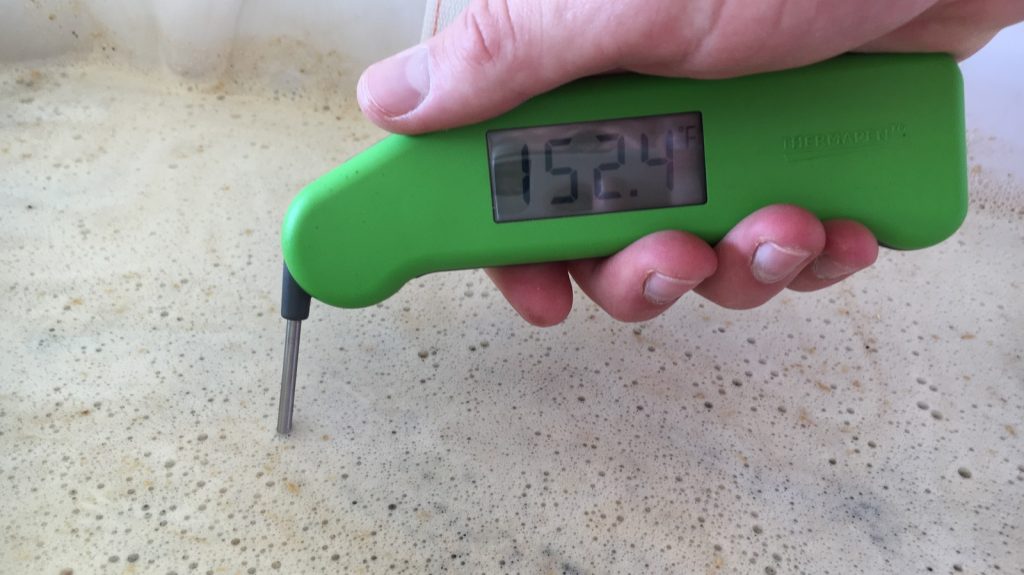
I collected the entire volume of sweet wort after a 60 minute rest.
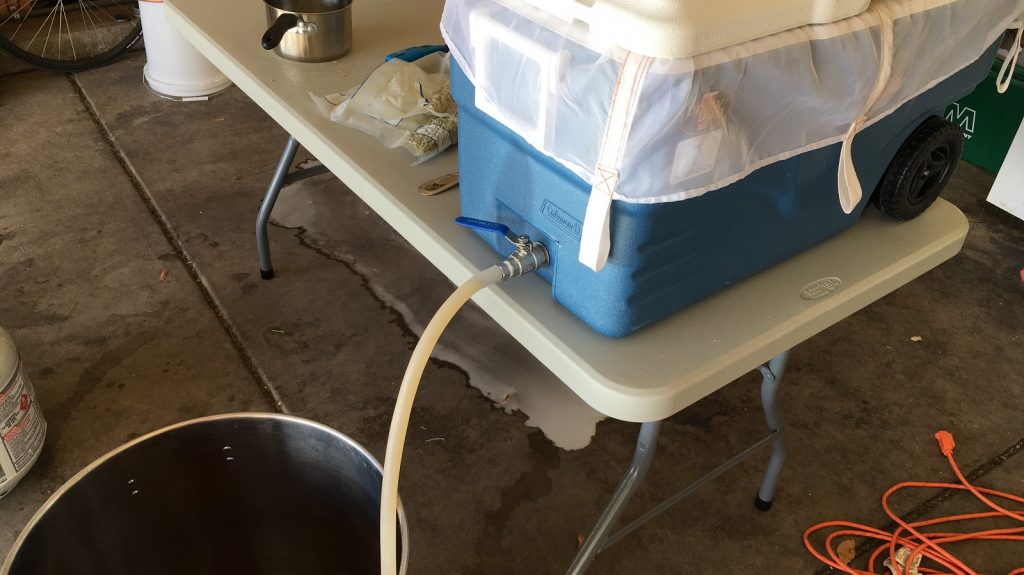
The wort was then boiled for 60 minutes with hops added at the times stated in the recipe.
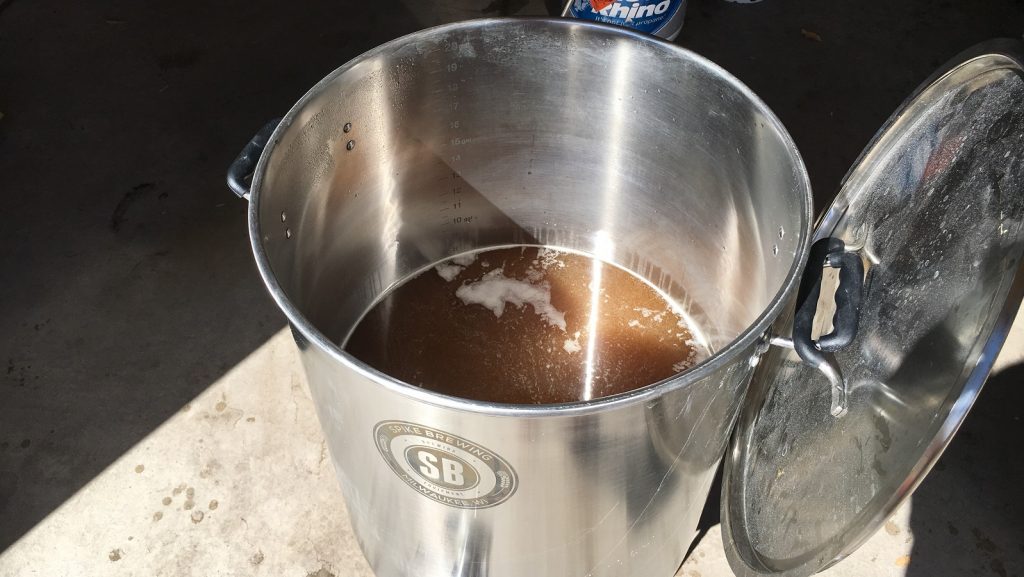
Once the boil was complete, I killed the flame and rapidly chilled the wort to my groundwater temperature of 58°F/14°C.

The chilled wort was split equally into two 3 gallon glass carboys.
A hydrometer measurement at this point showed I hit my target 1.046 OG.
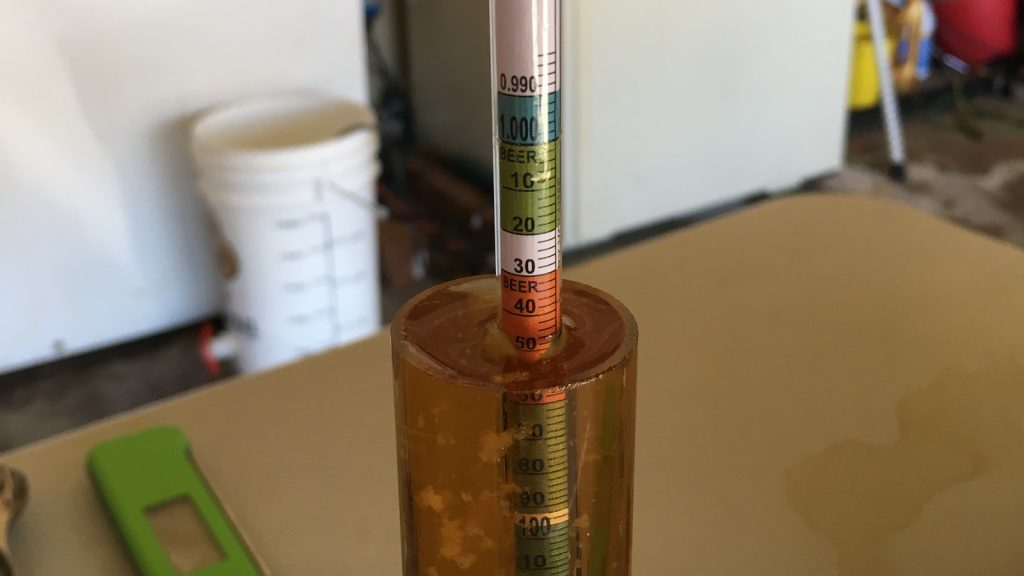
I placed the carboys in my cool fermentation chamber to finish chilling, returning a few hours later to find they’d both settled at my desired pitching temperature of 50°F/10°C.
I rehydrated a packet each of W-34/70 and S-23 in warm water before pitching them into their respective worts.
I checked on the beers 24 hours later and noticed slightly more kräusen development on the S-23 batch.
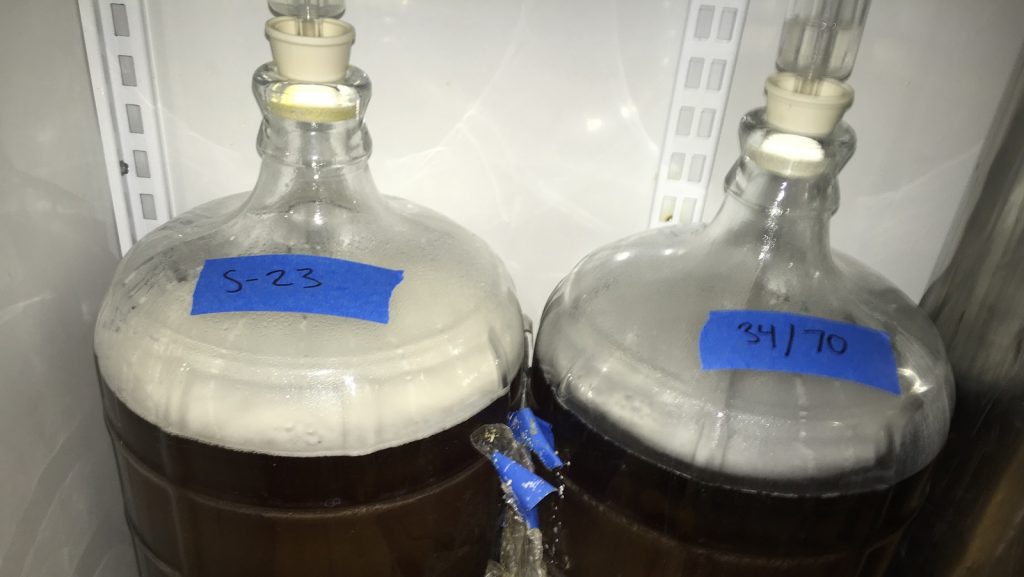
Any differences in fermentation activity were gone a few hours later and the beers progressed equally over the following 9 days. After 10 days at 50°F/10°C, I gently raised the temperature in my chamber 60°F/16°C over the course of a couple days. At 14 days, I noted no observable activity in either batch and took a hydrometer measurement confirming the same FG had been reached in both.
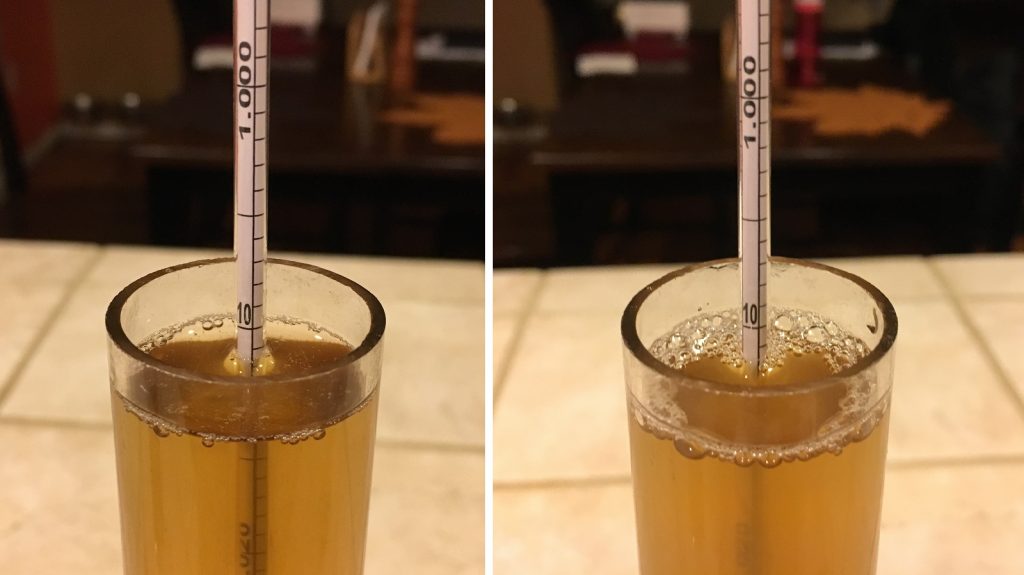
The beers were cold crashed, fined with gelatin, and racked to kegs.
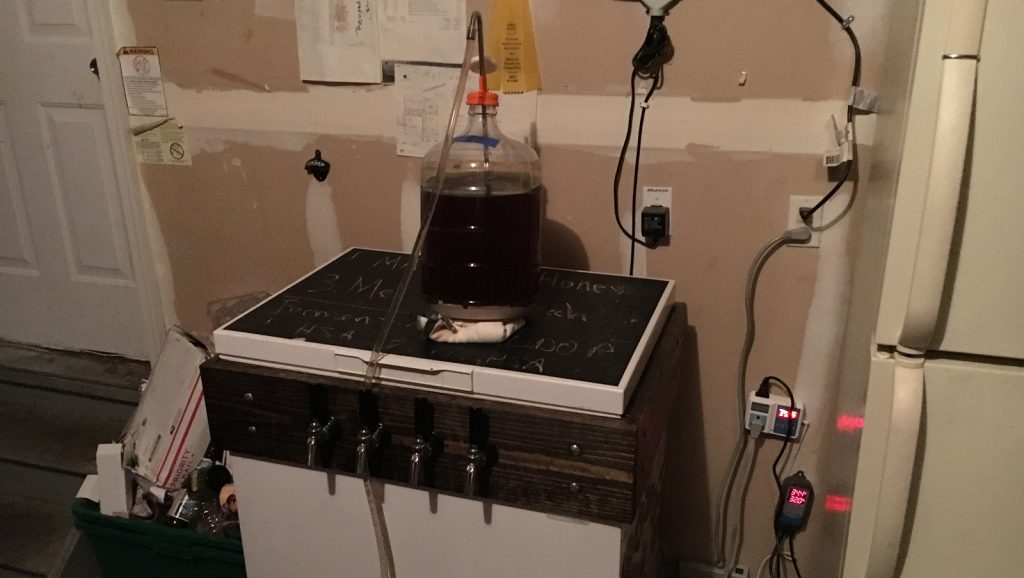
I placed the filled kegs in my keezer on high pressure for a brief burst carbonation, decreasing the gas to serving pressure the following day. I let the beers lager for just over a week before pulling samples to serve to unsuspecting participants.
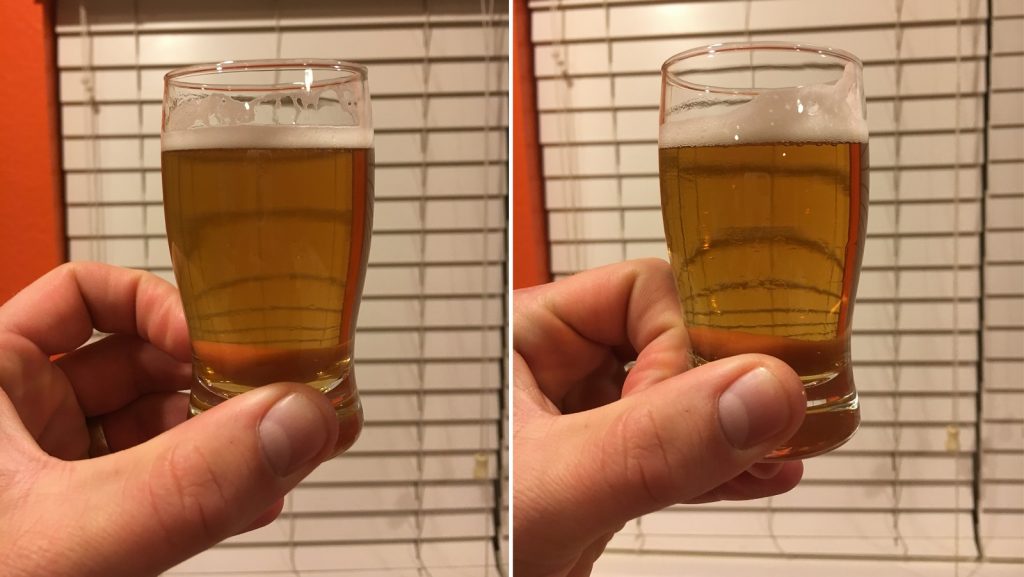
| RESULTS |
A panel of 18 people with varying levels of experience participated in this xBmt. Each taster, blind to the variable being investigated, was served 2 samples of the beer fermented with Saflager S-23 and 1 sample of the beer fermented with Saflager W-34/70 in different colored opaque cups then instructed to select the unique sample. A total of 10 correct selections would have been required to achieve statistical significance (p<0.05), though only 7 tasters (p=0.39) chose the different beer, suggesting participants in this xBmt were unable to reliably distinguish a beer fermented with W-34/70 from one fermented with S-23.
My Impressions: When sampling these beers the day after kegging, I was pretty sure they were different enough that I’d be able to distinguish one from the other, noting the batch fermented with W-34/70 had a subtle hint of sulfur on the nose while the S-23 beer was a bit cleaner. However, after a week of lagering in the keg, at the time of data collection, any differences seemed to disappear and I failed multiple triangle tests. In the end, I really enjoyed both beers and plan to re-brew a larger batch of this recipe, though I’m admittedly stunned with how indistinguishable they were, as I expected the S-23 batch to have a more noticeable fruity ester character.
| DISCUSSION |
Yeast selection has become a major focus for brewers, many relying on particular strains as the primary contributor to beer character. Indeed, different yeasts can impart unique aromas and flavors to beer, I trust most brewers are comfortable with this assertion. However, the results of this xBmt and others like it suggest some strains may not be as different as many of us presume. The fact tasters were unable to reliably distinguish a beer fermented with Saflager W-34/70 and one fermented with Saflager S-23 is interesting on its own, though what makes these results more surprising is that they run counter to claims by some that S-23 imparts unpleasantly high esters, which simply wasn’t the case for me. Perhaps ester expression from S-23 is related to OG, type of fermentation vessel, or even subtle differences in water chemistry. Given how clean both of the beers in this xBmt ended up being, I’d be lying if I didn’t admit to wondering if maybe the intense esters others have reported weren’t necessarily from the yeast but, you know, something else…
As similar as the beers in this yeast comparison xBmt were, the results didn’t cause me to change my feelings about Saflager W-34/70, I’ll still likely rely on it for the bulk of my lager beers, though it’s nice to know I can use Saflager S-23 to similar effect.
If you’ve used either Saflager W-34/70 or Saflager S-23, please share your thoughts and experience in the comments section below!
Support Brülosophy In Style!
All designs are available in various colors and sizes on Amazon!
Follow Brülosophy on:
FACEBOOK | TWITTER | INSTAGRAM
If you enjoy this stuff and feel compelled to support Brulosophy.com, please check out the Support Us page for details on how you can very easily do so. Thanks!


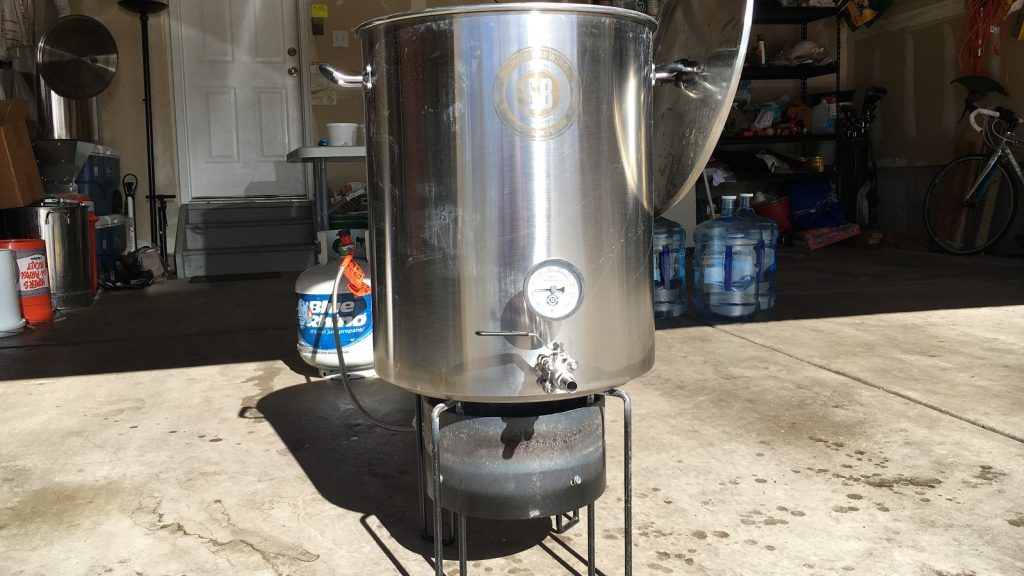
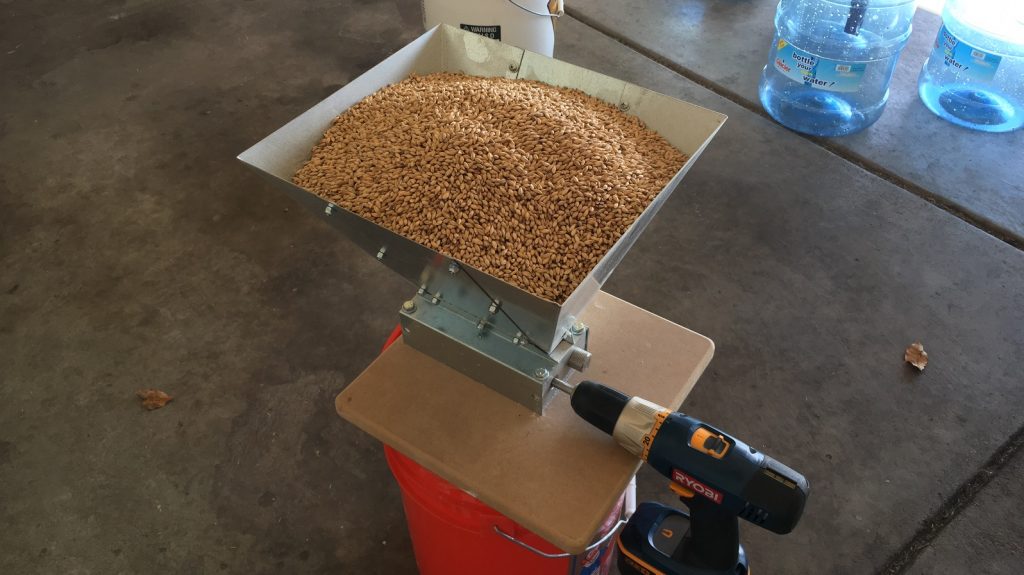
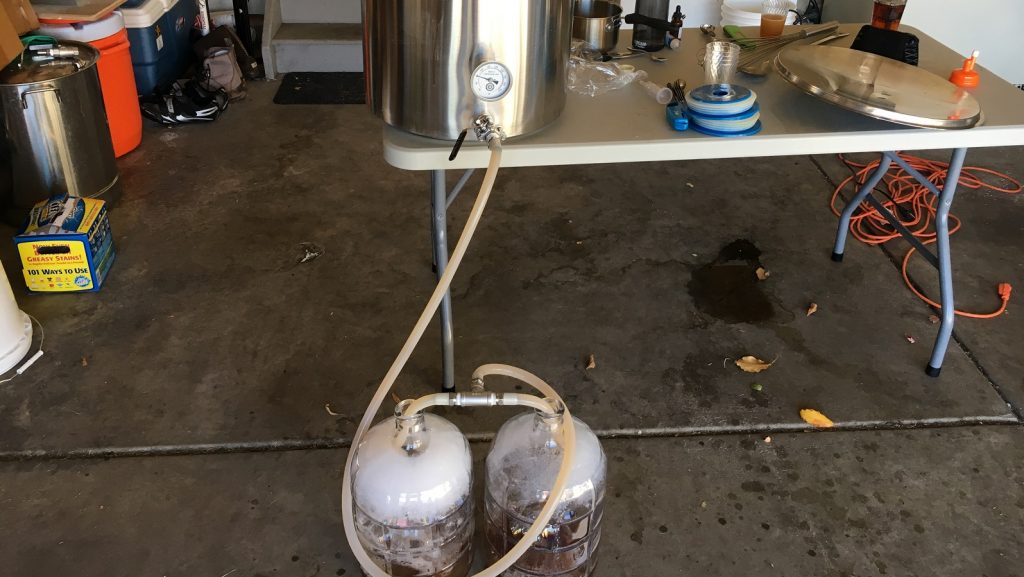
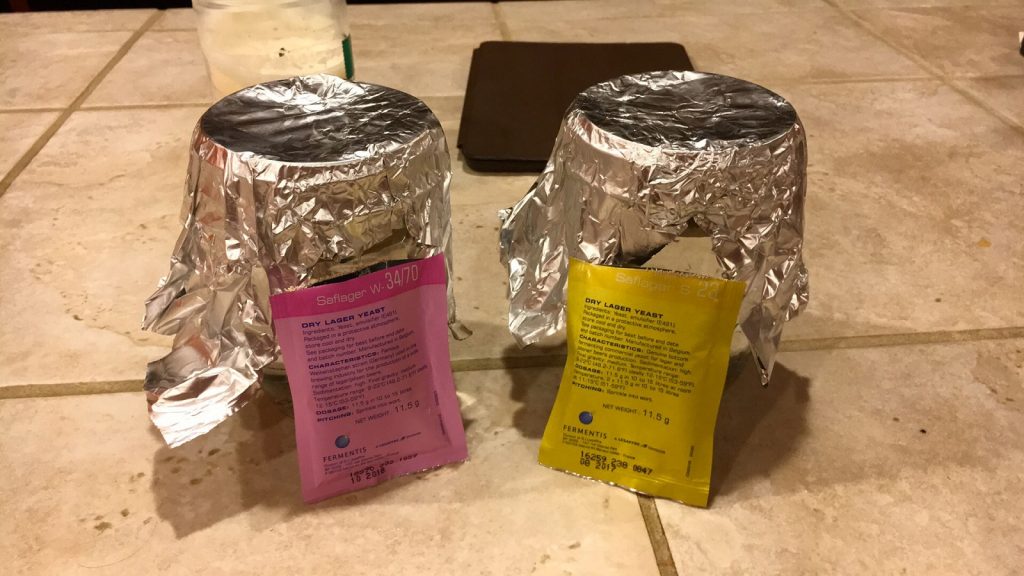





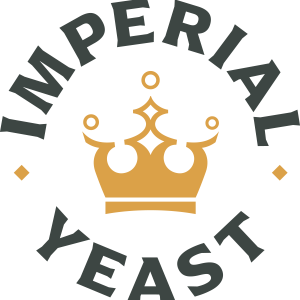

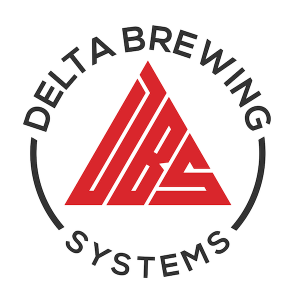


38 thoughts on “exBEERiment | Yeast Comparison: Saflager W-34/70 vs. Saflager S-23 In A Munich Helles”
I’ve been wondering about this as my local shop carries only S-23, not the 34/70 that I’ve been using (and paying postage for). I wonder if S-23 produces those alleged esters when fermented at ale temperatures? Only one way to find out.
I did a batch of Czech Pils with S-23 recently. Fermented at 65* and lagered in the keg. It turned out nice and clean, no fruity esters, a very drinkable beer. I’m really happy with it, I plan on using that yeast in the future.
I have been brewing lagers a couple times per year using the 34/70 yeast with very good results. No problems. I just recently started using two packets of yeast for a 5 gallon batch. I have read that I should double up the yeast for lagers. Previously I was only using one packet of yeast per 5 gallon batch. Still, even then no problems.
You always use 1 packet for a 5 gallon batch of 1.060 or less OG beer? I have been using 3 packages, as it always seems 2.X are required if using the pitching rate calculators. Maybe I’ll start just using 2 packages and see how that goes.
Each carboy only held 3 gallons or a bit less in this xbmt
Since this batch was 2.5 gallons of 1.046 wort one sachet was enough per my preferred calculator. That being said, results of quite a few xBmt have suggested you could be just fine pitching 1 sachet in a 5 gal of 1.06 or less.
I consistently use only one packet of 34/70 for 5 gallon batches without issue. I know that is not recommended but it works for me…
There has been an xbmt on this very thing! https://brulosophy.com/2016/11/07/yeast-pitch-rate-pt-5-underpitch-vs-overpitch-in-a-lager-exbeeriment-results/
I ‘harvest’ my S23 after brewing , it’s easily done. It stores well in the fridge and leaps into action when used in a subsequent brew. I’ve done 3 consecutive brews this way with no discernible deterioration in the yeast or any ‘off’ flavours,
This is great info for someone looking to brew their first lager in the next couple of months. I’ve been researching to see which saflager best suited my recipe but now I can rest easy and just go with whichever is in stock when I’m ready to brew. Thanks.
After reading here about the experiment with 34/70 at warmer temps, I did a similar experiment a few months ago. I brewed an 11 gallon batch of German Pilsner with a grain bill of 100% German Pilsner malt. I split it and used 34/70 and S-23. I used 2 packets of yeast in each fermenter. In full disclosure, I don’t bother to rehydrate; I just sprinkle on top. I don’t have a fermentation chamber, but I do have a room that stays quite cool, so with the assistance of the swamp cooler method, I fermented them around 62F for 8 days or so, then let them come up to about 68F for another 6 days.
In my experience they came out very differently. However, my experiment was not quite as controlled as this. The 34/70 went right to the keezer and was allowed to carbonate at serving pressure for a week. The S-23 was keg-conditioned with a little sugar and stored in the mid 60s. It was put in the keezer about 6-7 weeks later after the first keg kicked.
While I was never able to directly compare them, the 34/70 batch was everything I could ever ask for. It had sulfur notes, was crisp and clear and utterly delicious. I will admit I was on a high that I had made my first lager. I had always accepted that I would be unable to “lager” since I had no way of controlling the fermentation at lower temps. This was my first and has settled into my brain as “the best beer I EVER made!” I’m sure my mind added some hyperbole there, but regardless, I can’t wait to brew it again. Any of my friends who came by and drank it were also quite suitably impressed and I got more than a few, “Seriously, you made this?” My very supportive wife also rates it as one of my top beers.
Which brings us to the S-23 batch. It doesn’t hold a candle to the 34/70. It’s fine, it’s quite drinkable, but every time I drink one, I think I should have just gone with 34/70 all around. It is much fruitier and has a cloying sweetness to it. At one point, I wondered if maybe the additional sugar didn’t fully ferment during conditioning, but I don’t think I’d characterize it as just a “sweet” characteristic. It’s been in the keezer for 2 months now and while it improved over time, it’s still not what I want it to be. My wife still tells me, “Sorry. I love your beers, but this is probably my least favorite you’ve ever made.”
A few weeks ago I stumbled upon a random internet post somewhere where a guy mentioned he was going to use S-23 in an upcoming brew. Someone responded, “I hope you like passionfruit.” Bam! Like a lightbulb, that was it! I think that was a great way to describe it. There’s a character that I sometimes find in tropical fruits like passionfruit, guava or papaya. A different kind of sweetness.
Considering this xBmt, I wonder if my differences were related to warmer fermentation temps, lack of hydration, or something else? After my experience, I think it will be some time before I try S-23 again. I’m looking forward to brewing another batch of this pilsner. I will definitely use 34/70 again, but I’m on the fence about doing a split with another yeast. In the end, I’ll probably try another lager yeast in the 60s, maybe S-189. On the other hand, that 34/70 was the best EVER, so……
You said you held the s-23 batch at room temp for 6-7 weeks? I’d be inclined to think that may have somewhat changed the character of the beer. I’ve made a few with s-23 now and never had anything close to passionfruit.
34/70 is so good, id say stick with since it made your favorite beer to date.
I wonder if a lager isn’t the best to try keg conditioning at room temps. Perhaps the next batch, I should just stick with 34/70. I’ll put one right in the keezer and the other I’ll keg condition for 6-7 weeks and see if they vary much.
Did they both have the same OG and FG? You said you were worried about S-23 maybe not fermenting all the way. FG reading vs. the 34/70 batch would tell you if that were true.
Yes, they had the same FG. It was an 11gal batch with an OG of 1.054. After fermentation, both ended with a FG of 1.010. I did add a small amount of sugar to keg condition the S-23. I never did check the FG post conditioning. I suppose it’s worth a shot. I’ll check it before the keg gets kicked to know for sure.
While I’ve never done these side by side I have used both and to me s23 gave off an unpleasant “raw dough” character at first that went away with laggering, but I get a cleaner beer faster with 34/70. Did you notice anything like this?
I cannot say that I’ve gotten something I’d characterise as raw dough with s-23.
34/70 is just so good I’ve personally stuck with it more.
Yeah, I had the same “raw dough” character when I used S-23.
Also it seemed to start and ferment faster at 9C, however I’m not sure about that.
I recently fermented the same batch of German pilsner split between 34/70 and s-23, At times I feel like I can tell a difference but if there is one, its very small. I recently shared them at a homebrew club meeting, most seemed to prefer the 34/70 but all agreed they were very similar and no one commented on detecting any ester character.
I did not do any triangle tasting, but I’d like to. Have you written about your process for serving large groups (30-70)? What kind of cups do you use, do you reuse them? How do you label them, stickers, markers? Do you dispense the beer straight from kegs or do you pour it into pitchers first? Have you ran into temperature or carbonation inconsistencies? Do you pour all 3 samples at once for the entire group or each person one at a time?
I love all the experiments, keep it up thanks!
W34/70 is a beast. I even used the same yeast cake 4 times with no off flavors. I treat it like US05.
I am about to brew and throw it onto the same W34/70 yeast cake for the 3rd time. I’ve never had any undesirable results…yet
I’m also wondering if estery results for S23 were temp related. S23 call for temps of 12-15*C “Ideally”, as does W34/70, but the latter says it’s OK up to 22*C.
We’ve only made one lager so far, using W34/70, made in winter when our cool storage was at 10*C, and it was a bit sulfury until it aged out some. Now that we have a temp controlled chamber, we’re hoping to make another one soon.
Thanks for the exbeeriment, guys!
I have never used S-23 but have for many years used Wy2124 (WLP830) and this is great information to know. Unlike Jake I have found major differences in lager yeast in terms of flavor, attenuation and processing. 2124 is simply is the most versatile lager yeast, most attenuative, and can handle higher ferment temps. Beware it can leave diacetyl in your beer. My other favorite yeast which has more diacetyl risk is WY2001. I shy away from WY2000 as it it seems to have even higher risk of diacetyl and lower attenuation. If one wants to make Czech pils with no risk of diactyl I suggest WY2178 or 2042 Danish (PS I am not affiliated nor promoting Wyeast, I just have more experience using their yeasts or White Labs for that matter). Both of these do no attenuate as well as 2124 or 2001 in side by side fermentations and do not do as well in higher alcohol lagers (6 – 9%). For the Frohberg strains I have used WLP 833 and WLP 838 recently and find 838 to produce a more malty beer and both seem to attenuate the same. Right now I have WLP835 and WLP830 going in a Dunkel. I also like WY2206 but again does not attenuate as well as 2124. While much of my experience I would consider not totally controlled experiments I have made 150 lagers in 27 years and almost always split with two yeasts, chill to 44 – 50F, ferment at 50F then do a diacetyl rest to 58F and lager in carboys for the standard 4 weeks plus 1 week for every degree plato over 4 at 32F.
Thanks for sharing these results.
Cheers,
Jim
Thanks for sharing, id be interested, you say you notice big differences in lager strains, do you triangle test yourself on these? I used to think I noticed massive differences in “the same” beer until I started triangle testing. For me it was very eye opening, perception is a strong lead in to bias I think
I mostly jut do blind tastings comparing each one with other brewers and discuss. Going forward I will try to do more triangle tests which I did with 838 and 835 in a fest style beer and the differences in malt character were very evident. Some yeasts I’ll bet I could not tell the difference. 2206 to 838 for example. Or 2278 to 2042 may not be detectable. I have a Czech Pale Lager with 3 different yeasts and when it is ready I will do the blind triangle test to see. I do agree that the differences are much less than with ale yeasts due to the desire of minimal esters or other compounds. The other differences come in the way of performance, Sulphur production, temperature tolerance hot and cold.
And I am biased towards WY2001, WY2124 but still try different yeasts. Much of the bias comes with great results that may or may not be attributed to technique versus yeast. Lastly, each yeast may have an optimum ferment profile, O2 need, pitch rate and therefore sometimes I feel like I have given one the “home field” advantage.
Cheers,
Jim
I’ve tried to use S23 many times without much success. I’ve always had issues with Diacytel with or without a rest. The W34 has never done it, knock on wood.
Marshall, any plans to test these two fermenting at your usual ale fermenting temp (66 degrees)?
While I’ve only ever used liquid lager yeast, I agree that lager yeasts are all very similar with the exception of the difference between Pilsener and German yeasts. For instance, WLP830 and WLP833 are nearly identical. But WLP830 and WLP800 are very different.
The results you had are similar to my use of S-23. My local homebrew store stocks S-23 and not the other one so I used that awhile back. I’ve used it on three different batches of a Czech Pils and two batches of Baltic Porter. I’ve never had fruity esters and it’s always been a very clean finish. I really like the yeast. If you do an internet search it seems like a lot of people don’t like it and have all kinds of problems with the esters. I’m not sure where that discrepancy comes from.
I’ve been splitting these two types of yeast for a noumerous batches of beer. I found out that with dark lagers s-23 produces much more clean and tastier beers, meanwhile the w-34/70 gives more sweet beer that I dont find appealig. On the other hands with pale lagers the story is reverse. The 34/70 gives better amd richer tasting beer while s-23 is more empty only bitterness is present ( something like tasting an ale) the difference ofcourse is subtle and that drives me nuts as I can’t determine what to use more.
I have used both these yeas strains with very good results. Depending on my OG I will use 2 1/2 to 3 packs rehydrated on a stir plate plate.
My experience with S-23 is that those fruity notes can really come through and potentially ruin the beer. I cannot recommend it. I preferred the beers I made with 34/78.
Thanks for doing this – good intel on those strains. I did want to find out what your reasoning for the blackprinz in the helles was. The Vienna I think I could kind of understand (would be interested in your thoughts on that in a helles, too), but as you added salts/acid it seems, it didn’t seem to be intended as a pH adjustment. If an SRM adjustment, curious about your feelings on upping the SRM on the helles. Thanks again for the info!
BP was added purely for color adjustment. I’ve stopped doing this and just accept my helles looks much lighter than german examples.
Ah, okay – I wonder if the darker color you’re seeing in German examples is either a maillard thing from them decocting, or possibly pure age from export/etc. Either way, thanks for the additional info.
Count me among those who have had fruity experiences with S-23, which stand out in my memory compared to other lagers I have brewed. I can accept that it might perform well when treated well, and maybe I mistreated it. How about doing this experiment again fermenting at the higher fermentation temp range where you have found 34/70 to perform well?
I brewed a Pilsner with 100% pils and S-23. This yeast fits a Pilsner wonderfully. I really enjoy how the yeast notes and the pilsner malt flavor interreact. I didn’t do a really hoppy version, just wanted the malt and yeast to shine. I did cold age/lager for 2 months before serving
pretty old topic, but let’s give it a try…
in my practice – when fermentation is done at 10-11oC both strains perform the same and the profile is similar
i have seen that with temperatures going in the 6oC range and below – the W34/70 produces more sulphur…and with temperatures going above 12oC – it tends to become more phenolic…
S-23 is more forgiving in both cases…and indeed – it does produce some fruity esters, (without phenol), that go very well with noble hops aroma…
we use S23 (also Fermolager Berlin) and ferment @ 12oC because we want the esters
normally we mature 45 days before kegging and at that point the beer (vienna keller) is indeed fruity and hoppy
after a month or so – this goes away (unfortunately) but leaves a very good, clean and complex taste